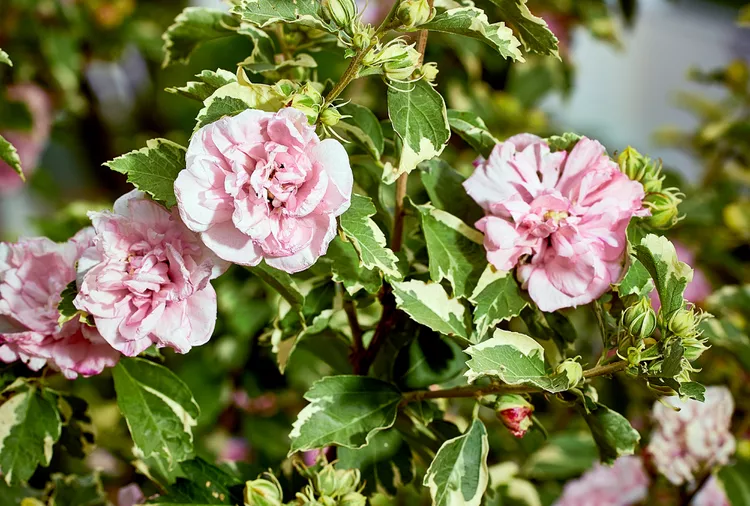How and When to Prune Rose of Sharon

The large size and vigorous growth of a rose of Sharon (Hibiscus syriacus) may inspire you to pick up a pair of garden pruners. But before you do, there are a few things to know about how and when to prune a rose of Sharon properly.
This fast-growing woody shrub beckons pollinators with its summer flowers. But an annual pruning can help it produce even more or larger flowers and keep stems in bounds in small-space landscapes. Here are 9 simple tips for pruning rose of Sharon to get a more compact shrub filled with flowers from midsummer until the first frost.
When to Prune Rose of Sharon
The best time to prune rose of Sharon is early spring before the leaves appear. The leafless branches make it easy to see the shrub’s form and shape. Flower buds for the upcoming summer are produced in spring. If you live in a cold climate, choose a warm, sunny day for the most pleasant pruning experience—a large shrub might take a decent amount of time to cut back.
One of the last shrubs to unfurl its leaves in spring, rose of Sharon is known to leaf out as late as June. This fact is always surprising to those growing rose of Sharon for the first time. The plant is likely alive and well, simply taking its time to join the plants bursting forth all around it.
Tips for How to Prune Rose of Sharon
1. Remove the 3 Ds.
Clip away dead, diseased, and damaged branches any time of the year. Cut the compromised branch back to live wood, taking it all the way back to the main stem or ground level when necessary. When you prune in spring before the shrub has leaves, determining whether a branch is alive or dead can be challenging. Here’s a trick: scrape away a bit of the bark with your thumbnail. The branch is alive if the tissue right under the bark is light green. Also, dead branches often have a brittle, lightweight feel to them.
2. Make cuts one by one.
For the most pleasing shape, selectively cut some stems back to side branches and cut other stems back to the main branch or ground level. Cutting stems one at a time, instead of shearing the plant, takes longer, but the result is a natural shape that blends well with nearby trees and shrubs.
3. Prune more for big flowers.
Removing about one-third of the length of each branch pushes a rose of Sharon to produce larger flowers. Significant pruning like this reduces the overall number of blossoms but dramatically increases the size of flowers the shrub produces. Even with significant pruning, a rose of Sharon will bloom from midsummer through fall.
4. Prune lightly for lots of small flowers.
Cut only a few inches off the overall height and width of a rose of Sharon in spring to encourage the plant to produce lots of little flowers. Count on flower buds to develop all along the remaining branches. Minimal pruning spurs the plant to produce hundreds of smaller flowers, as opposed to significant pruning, which pushes the plant to produce fewer, larger flowers.
5. Remove no more than one-third of the stems in a year.
It might be tempting to reduce a very overgrown rose of Sharon shrub to more than half its original height but resist the urge. Removing too much growth can weaken the plant. Remove no more than one-third of the plant’s overall size in a year. If your rose of Sharon needs rejuvenation (a drastic cut back), spread the trimming over three years, removing one-third of the excess growth each year.
6. Prune rose of Sharon in pots more frequently.
Keep a potted rose of Sharon in bounds by cutting it back in early spring as you would an in-ground plant. Give it another trim in midsummer and late summer if needed. Frequent trimming doesn’t harm the plant and helps keep its vigorous growth in check in the close quarters of a container.
7. Pruning is not required.
If you don’t have the time or inclination to prune a rose of Sharon every year or so, rest assured it won't hurt the plant. This shrub does not require pruning to grow and flower well. But given its speedy growth rate, rose of Sharon will reach its full size in a couple of seasons so make sure to plant it where it can freely expand. Note that the branches of plants that are not pruned often develop an irregular, somewhat floppy habit, giving the plant an informal appearance.